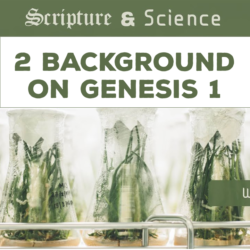What happened in Egypt during the ten plagues? Approaching the matter from a scientific perspective, our teacher, Will Barlow, brings to light some interesting connections. Probably most of us think God’s miracles are akin to magical interventions where he breaks the laws of nature to perform a supernatural feat. As we saw last time, the bible doesn’t require that view nor does it shy away from offering details occasionally about how God achieved the miraculous. Drawing on the work of Colin Humphreys, Barlow takes a close look at the events surrounding Israel’s exit from Egypt, including the timing of the event, the number of people involved, the ten plagues, and the location of Mount Sinai.
Listen to this episode on Spotify or Apple Podcasts
See below for notes.
—— Links ——
- We are doing follow-up discussions to these episodes on YouTube. Check them out!
- See other episodes in this Scripture and Science Class
- Check out Barlow’s previous podcast episodes
- Learn more about and support the church Barlow and his team are starting in Louisville, KY, called Compass Christian Church
- Find more articles and audios by Barlow on his website: Study Driven Faith
- Support Restitutio by donating here
- Designate Restitutio as your charity of choice for Amazon purchases
- Join our Restitutio Facebook Group and follow Sean Finnegan on Twitter @RestitutioSF
- Leave a voice message via SpeakPipe with questions or comments and we may play them out on the air
- Intro music: Good Vibes by MBB Attribution-ShareAlike 3.0 Unported (CC BY-SA 3.0) Free Download / Stream: Music promoted by Audio Library.
- Who is Sean Finnegan? Read his bio here
—— Notes ——
The Miracles of Exodus
• Background
• The Ten Plagues of Egypt
• A Possible Route
Background
Colin Humphreys received a Ph.D. in physics from Cambridge University. He is also an expert in chemistry, astronomy, and geology. He has spent a great deal of time and effort researching ways to reconcile Scripture and science.
Dating the Exodus
• If we take the evidence from Exodus 1:11, the Hebrews built the city of Rameses (1300 BC)
• But 1 Kings 6:1 seems to indicate that the Exodus occurred 480 years before the Temple (1446 BC)
Humphreys prefers the later date because it is easier to reconcile historically.
How then can we understand the 480 years of 1 Kings 6:1?
The Septuagint says 440 years, and this is a great clue. Really, 480 years could be an approximation based on the numbers of generations since the prior events.
Humphreys actually goes much further than this. He demonstrates that there are 14 high priests starting from Aaron and ending at Azariah, the high priest at the time of the construction of the Temple of Solomon.
But Aaron is 2 generations old (age 83) and Azariah is at least one generation old:
13 – 2 + 1 = 12 generations
12 * 40 = 480 years
Instead of 480 years, we can think in terms of 12 generations
If a generation is actually 30 years, then 12 * 30 = 360
If a generation is 25 years, then 12 * 25 = 300
This puts Exodus 1:11 and 1 Kings 6:1 in harmony (~1300 – 1250 BC)
How Many People?
Numbers 1:45-46 So all those listed of the people of Israel, by their fathers’ houses, from twenty years old and upward, every man able to go to war in Israel– 46 all those listed were 603,550.
This seems to imply ~2 million people in total
Scriptural problems with this large number:
• According to Herodotus, 600k men in the Israelite army would have been larger than the Egyptian army and the armies of the nations in the Promised Land
• Exodus 1:15 names two Hebrew midwives, which would be inadequate for a population of 2M people
• Deuteronomy 7:7 explicitly says that the Hebrews were the “fewest of all peoples”
• Numbers 3:43 states that there were 22,273 first-born males. If you divide that by the approximately 1M total males, you end up with an average family size of approximately 50 sons and 50 daughters!
How can we reconcile this?
• The word translated “thousand” can also mean “group” (as in family, clan, or troop).
• Humphreys proposes the translation of “troop” instead of “thousand”
Numbers 1:21 those listed of the tribe of Reuben were 46,500 [“46 troops and 500 men”].
46 troops = 500 men
~10 men per troop
~10 men per troop matches with the clay tablets found in Tell el-Amarna
This leads us to conclude that the total men, women, and children were approximately 20,000 at the time of the Exodus.
Generations earlier, the “children of Israel” numbered 75 people.
If we assume 2% population growth per year for 300 years, 75 people turns into 28,517 people.
To get to 2M, you would need to average 3.5% per year.
Historical sources estimate average population growth in Egypt during this era would close to 0.02% per year.
The Plagues of Egypt
Colin Humphreys gives one possible way to reconcile the plagues of Egypt with a scientific explanation of the events.
“The concept that for the ancient Israelites the miracles of God involved God displaying his power through control of natural events like earthquakes is so important…”
— Colin Humphreys, The Miracles of Exodus, page 23.
• Nile turned to blood
• Frogs
• Gnats
• Flies
• Death of livestock
• Boils
• Hail
• Locusts
• Darkness
• Firstborn
• Nile turned to blood — a combination of extra red soil and the red tide of harmful algae blooms invade the Nile rapidly and kill all the fish (September at the height of the Nile)
• Frogs — As the fish decay, the rotting smell would have driven the frogs and toads out of the Nile (Sept – Oct at the height of frogs)
3. Gnats — Possibly midges; able to reproduce and cause damage because the frogs and toads are gone (October/November)
4. Flies — Probably the stable fly, with a terrible bite that punctures the skin (can cause infection); these flies swarm and reproduce quickly (November)
5. Livestock — African horse sickness and bluetongue are two viruses spread by the midges from the third plague that only affect hoofed animals and not humans (November – December)
6. Boils — The stable fly is known to favor biting the lower bodies, which squares with Deuteronomy 28:35; the stable fly carries a bacteria that causes skin infection (December – January)
7. Hail — Exodus 9:31-32 notes that flax and barley were destroyed; this lines up with ancient Egyptian sources (February – March)
8. Locusts — Exodus 9:33 suggests that the land was very wet, the perfect conditions for locusts to lay eggs. They also travel on wind like Exodus 10:13 says (February – March)
9. Darkness — could have been caused by a multi-day sandstorm, known as a khamsin. Extra red soil deposits from the first plague could have made this particularly severe (March).
10. Firstborn — Mycotoxins on the grain from the damp conditions from hailstorm, sealed in the granaries due to the sandstorms. The firstborn animals and humans would have had priority on food.
Why were the Israelites unaffected by the plagues?
“The Israelite slaves lived in their own separate geographical location, the land of Goshen, which almost certainly was not in the prime property market area next to the highly desirable waters of the Nile, which the Egyptians would have kept for themselves….”
— Colin Humphreys, The Miracles of Exodus
“We have earlier identified the plague of gnats with the midge… and the plague of flies with the stable fly. Both would have been concentrated around the Nile…”
— Colin Humphreys, The Miracles of Exodus
“In addition, both the midge and the stable fly are weak flyers with a range of less than a mile…”
— Colin Humphreys, The Miracles of Exodus
“Hailstorms and sandstorms are frequently very localized, so it is easy to see that the geographically separate region of Goshen could have been spared by both the hailstorms and then the sandstorms causing the three days of darkness.”
— Colin Humphreys, The Miracles of Exodus
“The crops of the Israelites therefore would not have been stored damp in sand-covered stores and thus would not have developed mycotoxins, and the Israelites and their livestock would not have been poisoned by them.”
— Colin Humphreys, The Miracles of Exodus, page 146.
A Possible Route
Humphreys uses Biblical, historical, and geographical information to determine a possible route for the Exodus.
• Red Sea crossing at a location where backtracking was impossible and the water was somewhat shallow (Gulf of Aqaba)
• The Biblical description of the “pillar of fire” by night and the “pillar of cloud” by day, along with the terrifying description of Mt. Sinai in Exodus are both consistent with a volcano
• Using a variety of information, Humphreys locates a volcano that fits all of the evidence in Arabia (which is mentioned in Galatians): Mount Bedr
All the way, Humphreys explains various items, like:
• Water from the rock
• Manna
• Timing the route







If there were only 20000 Israelites then who built the pyramids. Seems you would need a lot more slaves.
Presumably, if the 20,000 figure is accurate, then not all labour on the pyramids was by Israelites!
By way of introduction, I am have a BAofEd in physics and math and taught high school science for 20+ years. My question is why do we need physical explanations for miracles in the Bible. If Dr. N.T. Wright is correct, then the physical earth and the spiritual heaven were created as a integrated whole. God could then use both realms to do His work. In both the fiery furnace and the lion’s den we are told angels came to protect men. There are many such examples of angels coming into the physical world in the Bible. Plus, the foundation of Christianity is perhaps the greatest miracle of all; Jesus being resurrected from the dead. This has absolutely no explanation according to modern science.